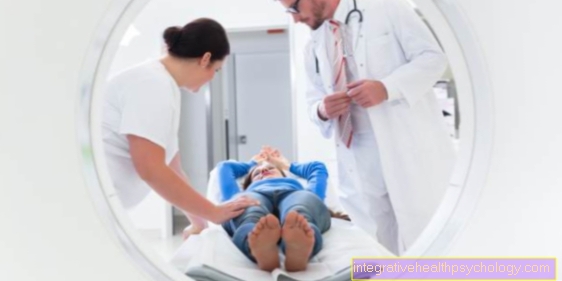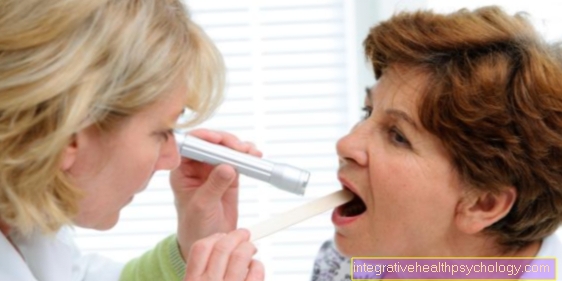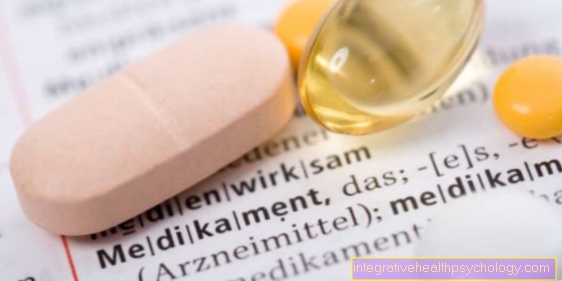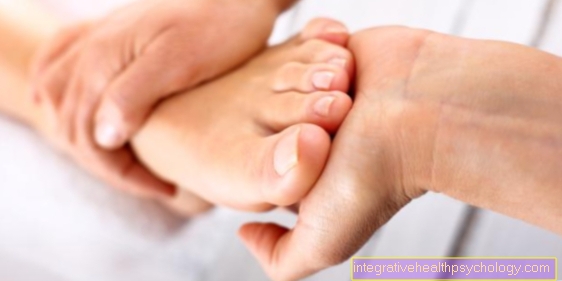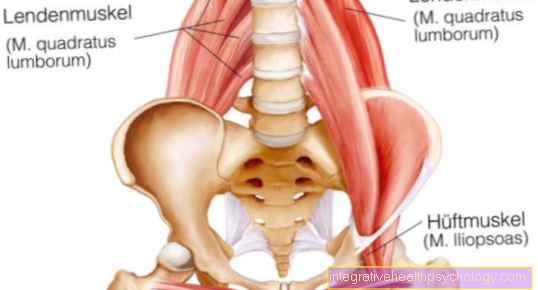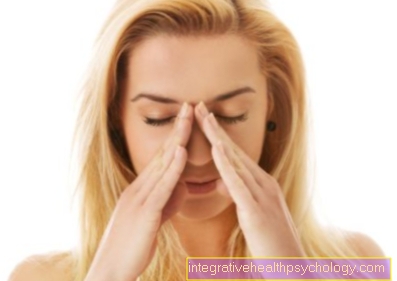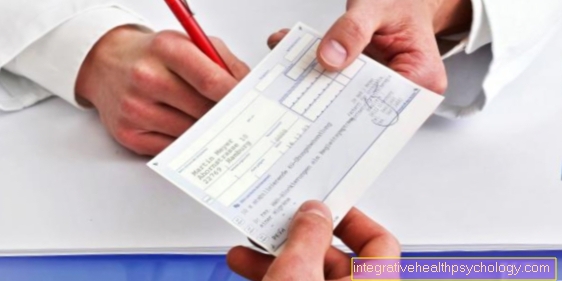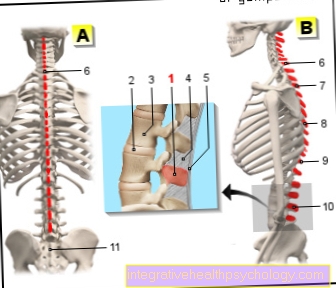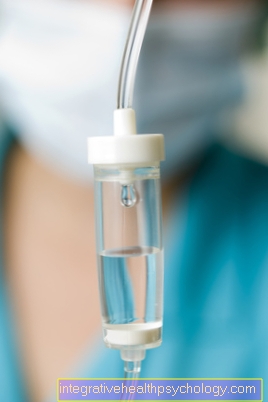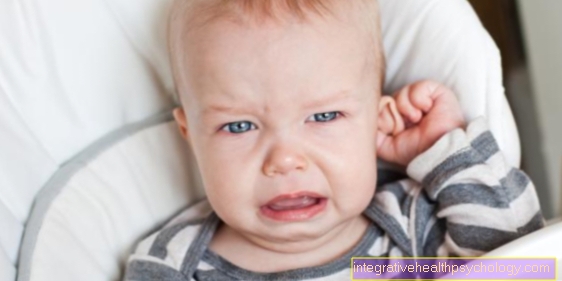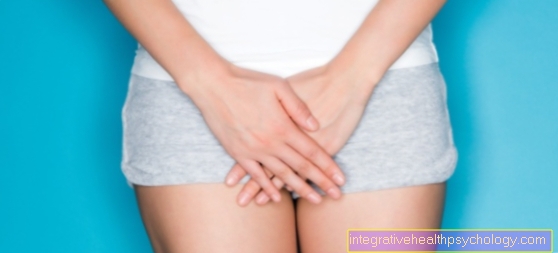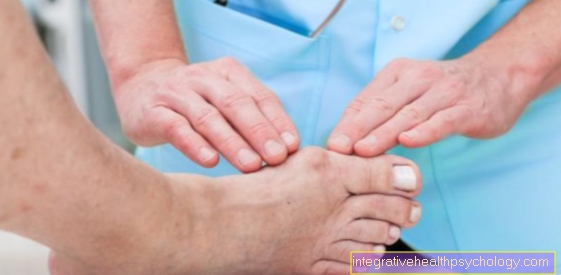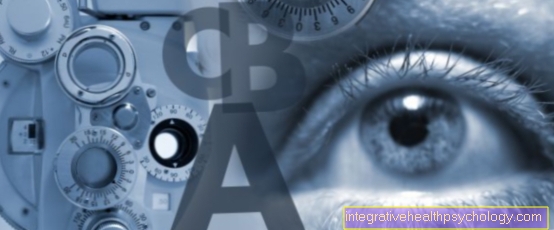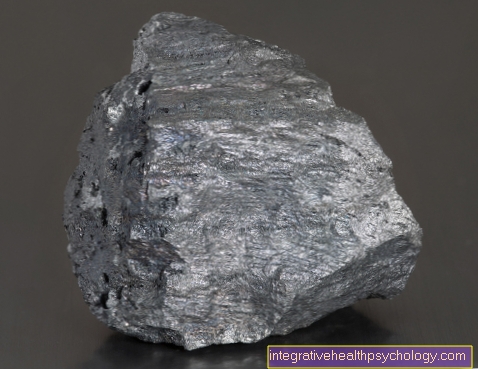The menopause
introduction
Menopause describes the last menstrual period caused by ovulation. The transition phase in which the woman loses her fertility is called climacteric or menopause. During this time, the ovaries lose their function, which among other things lowers the estrogen level. But other sex hormones are also subject to changes.
The phase before the last ovulation is called premenopause and the one after it is called postmenopause. The time around the last ovulation is called perimenopause. During this time, some women experience various symptoms, while others experience no change other than the absence of a menstrual period.

The reasons
With age, the function of the ovaries decreases until it finally ceases to exist. This means that female egg cells no longer mature in the ovary and ovulation does not occur. The woman can no longer get pregnant. The process of maturation and ovulation are controlled by various hormones in the body, which are also responsible for a woman's cycle, which lasts approximately 28 days.
In addition, the ovaries, which are controlled by the two hormones FSH and LH, produce estrogen. When the function of the ovaries and with it the production of estrogen decreases, the equilibrium begins to fluctuate. The levels of FSH (follicle-stimulating hormone) and LH (luteinizing hormone) are too high, which among other things leads to bleeding still occurring even though ovulation no longer occurs.
These hormonal changes can lead to various symptoms and changes.
Find out all about the topic here: The hormones in menopause.
Typical age?
When it comes to the timing of menopause, there are big differences among women. The average age is 51 years. Menopause usually begins between the ages of 40 and 50. They can last up to the age of 62.
In women who smoke and have diabetes or other chronic illness, menopause occurs on average about two years earlier. Also, women whose mothers started menopause early tend to start menopause a little earlier.
In some cases, women go through menopause under the age of 40. Then one speaks of the climacteric praecox. There are various causes for the climacteric praecox. This can be genetic or due to other diseases, e.g. autoimmune disease or after radiation / chemotherapy.
In one out of a thousand cases, menopause occurs before the age of 30, which is often an enormous burden for the women concerned.
The symptoms
About a third of women experience no symptoms at all during menopause. Another third suffer from mild discomfort, while the last third is severely affected by the symptoms.
Common symptoms include headaches, hot flashes, sweats, and dizziness. In addition, there may be other complaints such as inner restlessness and irritability. Mood swings during menopause are also common. These can also show up in a depressed mood. In addition, menopause and nighttime hot flashes and sweats can cause insomnia.
Other possible symptoms are joint and muscle pain or dryness of the mucous membranes. Urinary tract problems can sometimes occur as well. In addition, the mucous membrane in the urogenital tract can change. Due to the lack of estrogen, the colonization of germs in the vagina changes and the mucous membrane becomes drier. The risk of infection increases. The urinary tract can also be affected. In contrast to the other symptoms, these changes do not go away.
Menopausal Symptoms? Read more about this.
The hair loss as a symptom
With age and menopause, hair thins out. The possible causes are numerous. Among other things, the cause can be the menopausal hormone change. An imbalance in male and female sex hormones is possible due to the drop in estrogen.
The resulting imbalance can trigger both hair loss and increased hair growth in another area (e.g. on the face). Unfortunately, there is not much that can be done about it. If hormone therapy is taken for other other reasons, it can be adjusted so that it has a positive effect on the imbalance.
Read more about this under: The hair loss in women.
The chest pain as a symptom
Chest pain during menopause varies greatly from person to person.Chest pain can also be very different in its nature - depending on the hormones, although the exact relationship between hormones and chest pain has not yet been conclusively clarified.
Some women experience severe pain because touching the chest is extremely uncomfortable. Sometimes there is a feeling of tension and in other cases a pulling in the chest. Many women already suffer from chest pain during their cycle. Due to the fluctuating hormone levels during the cycle, this occurs even in young women. But the breast also changes in other ways in the course of a woman's life through puberty and pregnancy and the associated hormonal changes.
During the menopause, changes in tissue remodeling can cause small nodules or hardenings in the breast. Initially, these are not dangerous. Clarification and monitoring by the gynecologist is important, however, in order to identify and treat possible malignant growths in good time.
The woman's chest pain? Find out more about this here.
The hot flashes as a symptom
Hot flashes are a classic menopause symptom that many women suffer from. The hot flashes often occur in combination with sweating. Hot flashes often start with a feeling of pressure in the head and then spread throughout the body. In addition, the affected women blush and the heart beats faster. The feeling of heat lasts for half a minute to several minutes. In many cases this is followed by a sweat.
How often a woman suffers from hot flashes varies greatly from person to person. However, over two thirds of menopausal women experience occasional hot flashes. The exact cause for this has not yet been scientifically explained.
More information on the subject Menopausal hot flash you'll find here.
The joint pain as a symptom
Menopausal joint pain is more common than expected. The knees, neck, back, hands, shoulders and hips are particularly affected. In addition to pain, stiffness or joint swelling can also occur. Muscle problems can also exist.
However, joint pain is not counted among the typical menopausal symptoms. The relationships between the two are not stable enough for that. However, there is evidence that the lower levels of estrogen have a negative impact on the joints. Apart from that, joint problems occur more and more with increasing age.
If the pain and impairment are severe, a doctor should be consulted for clarification. The joint discomfort may be due to other diseases, such as Rheumatism or osteoarthritis. In this case, other treatment options are available.
Also read the article: The joint pain.
Weight gain as a symptom
As a result of the lower level of estrogen, the distribution of fat changes, and belly fat increases. There is also a decrease in muscle mass. There are more reasons for weight gain in old age than menopause.
From the age of 25, the energy demand decreases continuously. In addition, physical activity also decreases. The fact that the excess fat accumulates around the stomach of all places is very unfavorable. Abdominal fat in particular is associated with increased blood pressure and increasing insulin resistance, which can lead to diabetes mellitus.
Given these negative consequences, it is important to watch your body weight during and after menopause. In this way, risk factors for age-typical diseases such as diabetes mellitus or cardiovascular diseases can be minimized. A balanced, healthy lifestyle with sufficient physical activity is recommended for this.
How do you eat healthily? Find out more about this here.
Sweating as a symptom
Sweating is one of the typical symptoms of menopause. During menopause, sweats in particular are more likely to be associated with hot flashes.
After a hot flash with a sweat, there is often a chill. In addition, some women sweat more at night. Hot flashes also tend to occur at night, so sleep disorders are common during menopause.
The nausea as a symptom
It is not only during pregnancy that women suffer from nausea due to hormonal changes. Nausea can also occur during menopause. As with pregnancy, the nausea is increased in the morning. Medicines can also be taken against nausea in an emergency.
The water retention as a symptom
Many women suffer from swollen legs, especially as they get older. But swollen legs can also appear at a younger age. The cause of this is water retention. Many women already know this from pregnancy.
Due to the hormonal changes, water retention (edema) can occur more frequently during menopause. But edema can also develop on the legs regardless of the menopause. The cause is a weakness of the veins and the lymph vessels, which are responsible for the transport back to the heart. Women in particular are more prone to weak veins than men. Compression stockings, for example, help to support the veins in transporting blood back.
How long do menopause symptoms last?
The symptoms appear even before the actual menopause. According to a study from the USA, the mean duration of menopausal symptoms is 7.4 years. In the worst case, the symptoms can last up to 13 years.
Women who have had hot flashes before the last period of bleeding tend to have longer symptoms.
What are the signs of menopause?
Irregular menstrual bleeding is often the first sign of the onset of menopause. In addition, hot flashes and sweats are common symptoms that appear early in the menopause. Sleep disorders, changes in libido, exhaustion, mood swings and muscle and joint problems can also occur.
The symptoms and complaints of menopause vary greatly from person to person. Some women do not suffer from any discomfort at all. For them, the onset of menopause is only noticeable through irregularities and a decrease in menstrual bleeding. Cycle irregularities can also have other causes, especially in younger women. Although some women can reach menopause early.
The signs of menopause? Read on here.
How is my libido changing?
In general, libido and sexual activity decrease with age as there is a decrease in sex hormones. As a result, sexual desire and arousal also decrease. In addition, many women no longer feel attractive as they get older, which also has a negative effect on libido.
Menopause is not the only cause of changes in libido in old age. Sexuality generally decreases with age - needs and desires change and diseases can occur that can restrict sex life. But men are also affected. In many cases, an open discussion about your own needs and those of your partner can help identify problems and find solutions.
But there is also a group of women who enjoy the freedom of menopause - no longer fear of an unwanted pregnancy and the changes in this phase of life, such as moving their own children - and who actively shape their sex life again.
The bleeding afterwards - what could be behind it?
In the event of bleeding after the menopause, a doctor should definitely be consulted for clarification, as serious illnesses could be concealed behind it. Malignant cancer must always be ruled out.
However, benign growths can also trigger postmenopausal bleeding (bleeding that occurs after menopause). These benign growths include fibroids or polyps in the uterus.
In most cases, postmenopausal bleeding is not a cancer. For example, bleeding can occur again during hormone therapy. The lining of the uterus also decreases, which can also cause bleeding. In rare cases, it can also be due to a thickening of the uterine lining.
In addition, the cause of the bleeding can also be in the vagina. Your mucous membrane will also decrease and become more prone to small tears, which will also lead to easy bleeding.
There are different treatment options depending on the cause. In some cases, the last bleeding may not have taken place. Only after a year after the last bleeding can one assume that menopause has occurred.
Find out more about the topic here: The bleeding after menopause.
What test can prove I'm going through menopause?
Menopause can be recognized by the different levels of hormones in the blood. To measure the hormone levels, blood is taken, which is then examined. During menopause, the two hormones FSH (follicle stimulating hormone) and LH (luteinizing hormone) are increased, while estrogen and progesterone, which are produced by the ovaries, are decreased. The remaining sex hormones are in the normal range.
By examining the hormone levels, it is not possible to predict whether ovulation will occur again or not - i.e. whether there is still a possibility of pregnancy or not. Due to the changed hormone levels, however, this probability decreases increasingly.
The AMH test can be used much earlier to estimate when the menopause will start. This test measures the level of anti-Müllerian hormone in the blood. It decreases on average from the age of 35. The concentration can be used to estimate how much the ovaries are still active. However, he cannot determine the exact start of menopause either. However, the test cannot be used in young women, since at this age there are generally no changes in the AMH concentration. The value also varies during the cycle, through hormonal contraception and during pregnancy.
The treatment
First of all, changes in lifestyle can lead to an improvement in symptoms. A healthy, balanced diet and regular exercise have a positive effect. Relaxation exercises or yoga can also provide relief. In addition, the consumption of coffee, nicotine, hot spices and alcohol should be avoided.
Hormonal substitution therapy is also available to alleviate symptoms. In addition, medication against sweating is available. However, these must be prescribed by a doctor.
There are several treatment options in alternative medicine. These include neural therapy and bloody cupping. In neural therapy, anesthetics are injected. With cupping, glasses are placed on the skin using negative pressure. In addition, bog baths are recommended. There are also herbal medicines whose active ingredient is said to have an effect similar to that of estrogen. One example is the cimicifuge rhizome. In addition, sage can be taken for sweating relief and lavender for calming.
The hormonal substitution
Hormonal substitution is a therapeutic option if the symptoms of menopause are so pronounced and cause a high level of suffering. These women can benefit from hormonal substitution. In addition, hormonal substitution is advisable if menopause begins too early or if there is severe tissue loss in the genital area, which has an increased risk of inflammation.
A combination preparation of estrogens and gestagens should be used in therapy. If progestogens are not substituted, the risk of malignant degeneration of the uterine lining is increased. With some pre-existing conditions, however, hormones must not be taken because the risk is too high. These diseases include liver damage, breast cancer, uterine cancer or thromboembolism (blood clots that block blood vessels).
There is a large variety of preparations for hormonal substitution, which differ in their dosage form. There are patches, tablets, coated tablets and hormone injections. There are various gels or creams available for local application to the vagina. The concentration of estrogen is lower than in the pill, which is used for hormonal contraception.
The length of time from onset to completion of menopause
From the age of around 35, the function of the ovaries slowly declines. And with it, the likelihood of pregnancy decreases. It takes several years until menopause actually occurs. On average, it only occurs at around 50 years of age. Menopausal symptoms usually only appear after the age of 35.
According to one study, the average total duration of menopausal symptoms is 7.4 years. Women who experience symptoms before the last bleeding suffered from menopausal symptoms for much longer on average (around 12 years). In women who experience the symptoms at a later point in time, they only last 3-4 years on average.
Contraception in menopause
Contraception is also very important during menopause. At this age, pregnancies are in many cases no longer desirable. In the age group of 40 to 45 year olds there are over a thousand abortions each year in Germany.
It is often difficult to say exactly when you can no longer get pregnant. As a rule, it is only a year after the last bleeding that you can be sure that it was the last bleeding and that you can no longer get pregnant.
In principle, all common contraceptives can be used during menopause, unless otherwise stated for other reasons. A conversation with the treating gynecologist can be useful and helpful in case of doubt.
What is the relationship between menopause and depression?
There is clear evidence that menopause is related to depression. Post-menopausal women, for example, are significantly more likely to suffer from depression than pre-menopausal women. However, it is unclear how much the changed hormone level favors the development of depression. It has been shown that menopausal women with hormone therapy are less prone to depression. It is believed that the estrogen has a positive effect on the serotonin metabolism.
Regardless of the menopause, there are other external influences that occur more often in this phase of life and can promote depression. In this phase, children may move out, changes in professional life, divorce or impaired sexuality can all have a negative impact on mood.
In view of this multitude of influencing factors, it is unclear how strong the connection between menopause and depression actually is.
Find out all about the topic here: The Depression.
What is the relationship between menopause and osteoporosis?
In osteoporosis, bone density decreases. Back and joint problems are increasing. As the disease progresses, fractures often occur without any external force such as a fall would be necessary.
Osteoporosis can be a long-term consequence of menopause. The estrogen had a positive effect on bone formation by inhibiting the cells that break down bone. In addition, estrogen promotes the absorption of calcium. If the estrogen level drops during menopause, this positive effect disappears and bone loss increases. The bone mass then decreases by 1 to 4 percent annually.
Every third to fourth woman over 50 in Germany suffers from osteoporosis. Hormone replacement therapy can be used to treat this osteoporosis.
Find out more about the topic here: Osteoporosis.
Can you postpone the onset of menopause?
The possibilities to influence the onset of menopause are limited. A number of factors are known that tend to be associated with a later onset of menopause. A healthy lifestyle tends to delay the onset of menopause. According to a study, green and yellow vegetables in particular are said to be effective.
Women who had their first menstruation at a very young age also have their menopause later on average. It is the same with obese women.Because the adipose tissue also produces estrogen. Several pregnancies or the use of birth control pills also tend to delay menopause.
Of course, genetics also play a role. If menopause started late in the mother, it also started a little later in the daughter. By contrast, smoking causes menopause to start two years earlier on average.
How does belly fat change?
The changed hormone levels during menopause affect many body functions. The low estrogen level also leads to a change in the body fat distribution.
Excess energy is increasingly stored in the abdominal area in the form of fat. Belly fat increases, which unfortunately is considered particularly bad. In addition to the falling estrogen level, there are other factors that favor an increase in belly fat. On the one hand, the energy requirement decreases in old age and, in addition, one is less physically active. It is therefore important to ensure a balanced lifestyle in order to reduce negative consequences such as diabetes mellitus or cardiovascular diseases. Specialized doctors can provide advice in this area.
Losing weight during menopause? Read more about this here.


